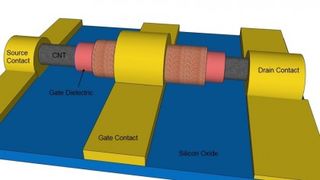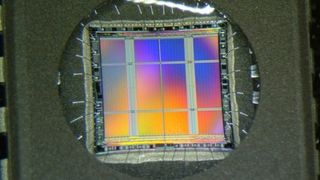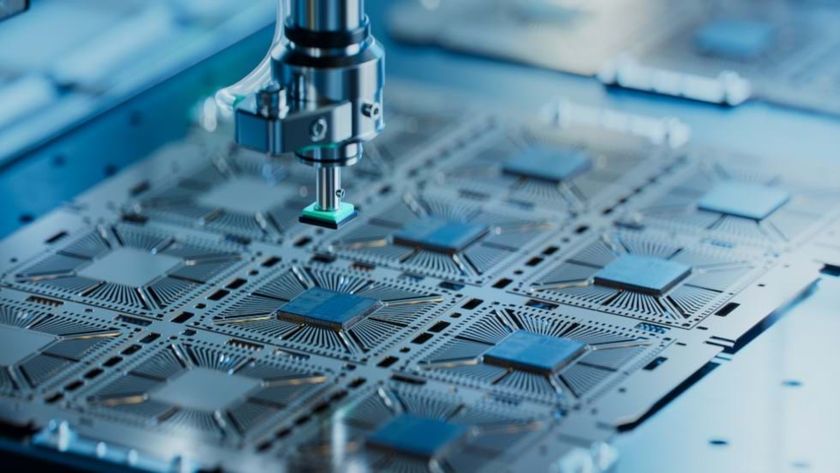Smaller, smarter, but maybe not much faster: The future of the CPU
Moore's Law won't apply for much longer. What happens next?

Size matters
In February, Intel's technology and manufacturing group chief William Holt told the International Solid State Circuits Conference that "we're going to see major transitions. The new technology will be fundamentally different." Predicting that Moore's Law – which states that processors will double the number of transistors every two years – would only hold for another two processor generations, Holt described two potentially revolutionary new technologies: tunnelling transistors and spintronics.
Tunnelling transistors, or to give them their full name, Tunnel Field-Effect Transistors (TFET), are similar to existing MOSFET switches but rely on quantum tunnelling to use much lower energy than other switching technologies. Such transistors could make a huge difference in CPU power consumption.
TFETs are promising, but they're also some way from production. Spintronic devices are much closer to reality – last year, Toshiba announced an experimental spintronic memory array that used 80% less energy than SRAM, and spintronics are expected to appear in high-end graphics cards over the next few years. Spintronics is another quantum-based technology, and it uses electrons' spin states to transmit data. It requires much less energy than traditional electronics, and it uses cheaper materials too.

Better, yes. Faster? Maybe not
As Holt explained: "The best pure technology improvement we can make will bring improvements in power consumption but will reduce speed." Speed is no longer the key consideration – energy efficiency is. "Particularly as we look at the Internet of Things, the focus will move from speed improvements to dramatic reductions in power," he further observed.
Whether it's the data centre or your smartwatch, the chips you've got are probably fast enough – but their energy usage is thousands or even millions of times higher than it could be in the not too distant future.
Intel is also working on ways to improve communications between CPUs. Its silicon photonics chips use lasers to communicate between devices, and while those lasers will initially be used to connect networking equipment inside data centres, in the longer term lasers will connect servers and possibly even replace the cabling inside computers and other devices – devices whose innards would literally communicate at the speed of light.
Hitting the limit
Back in 1961, IBM Research's Rolf Landauer used the second law of thermodynamics to calculate that there was an absolute minimum amount of energy required to perform a computer operation, and in 2012 a group of European scientists demonstrated proof of his theory: the heat released by a calculation was exactly as Landauer predicted.
Are you a pro? Subscribe to our newsletter
Sign up to the TechRadar Pro newsletter to get all the top news, opinion, features and guidance your business needs to succeed!
But the limit is tens of thousands of times lower than the energy used by today's silicon CPUs, and a process called reversible logic could one day create chips that get much, much closer and maybe even below Landauer's limit – which is useful in an increasingly mobile world where battery technology remains stubbornly opposed to great leaps forward.
This isn't just theoretical. In March 2016 engineers at UC Berkeley experimented with magnetic computing, and the results suggest that it may be possible to produce chips whose power requirements may be as little as one millionth of the energy per operation we have today.
According to senior project author and Berkeley professor Jeffery Bokor, "making transistors go faster was requiring too much energy. The chips were getting so hot they'd melt." The team used nanomagnets to control electrons, proving that the theory they'd published five years previously could be achieved in reality.
Don't expect a nanomagnetic CPU any time soon, but as the authors note: "The significance of this result is that today's computers are far from the fundamental limit and that future dramatic reductions in power consumption are possible."
This article is part of TechRadar's Silicon Week. The world inside of our machines is changing more rapidly than ever, so we're looking to explore everything CPUs, GPUs and all other forms of the most precious metal in computing.
- Also check out: 10 CPUs that changed computing
Writer, broadcaster, musician and kitchen gadget obsessive Carrie Marshall has been writing about tech since 1998, contributing sage advice and odd opinions to all kinds of magazines and websites as well as writing more than a dozen books. Her memoir, Carrie Kills A Man, is on sale now and her next book, about pop music, is out in 2025. She is the singer in Glaswegian rock band Unquiet Mind.











